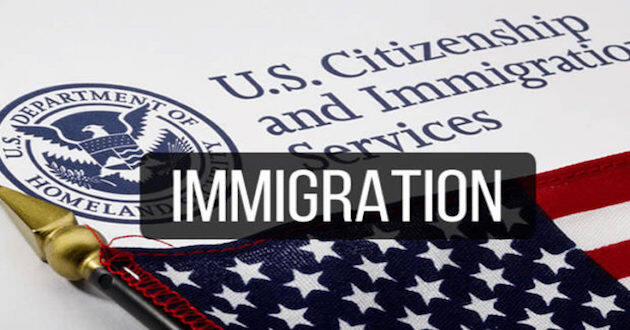Supreme Court rules in favor of Trump administration ‘public charge’ rule

The Supreme Court has voted to allow the Trump administration to enforce its “public charge” immigration rule in Illinois after previously allowing the rule to be enforced in other parts of the country.
The public charge rule, which was issued in 2019, provides clarification about what factors would be considered when determining whether someone is likely at any time in the future to become a public charge. A public charge refers to an individual who is likely to become primarily dependent on the government for subsistence through assistance such as food stamps or Medicaid.
The top court justices voted 5-4 on Feb. 21 to grant a stay on an injunction issued by a lower court in Illinois, allowing the Trump administration to enforce its “public charge” rule in the state while the appeal plays out in courts. This comes after the Supreme Court lifted nationwide injunctions issued by a New York District Court and upheld by the 2nd Circuit at the end of January.
The January decision allowed the Trump administration to enforce its rule across the country, except for Illinois, due to a separate injunction ordered by the U.S. District Court for the Northern District of Illinois that applied to only that state.
Justices Ruth Bader Ginsburg, Stephen Breyer, Elena Kagan, and Sonia Sotomayor voted to deny the government’s request to lift the Illinois injunction.
The rule will consider a person a public charge if they receive at least one government benefit for more than 12 months in a three-year period.
The Trump administration said the rule was implemented because it wanted to “see people coming to this country who are self-sufficient.” But opponents say the rule impedes immigrants and their families from accessing necessities such as health, food, and housing programs that supplement their wages and “help them make ends meet.”
The rule was challenged by several states and immigration groups, leading to injunctions that prevented the rule from going into effect on Oct. 15, 2019. Two federal appeals courts — the 4th Circuit and the 9th Circuit — lifted similar injunctions in December 2019. But the 2nd Circuit had refused to set aside a pair of injunctions issued by a New York District Court, prompting the Trump administration to file an emergency request (pdf) to the top court earlier in January to lift those blocks.
The Trump administration filed another request (pdf) to the top court on Feb. 13 to lift the remaining injunction affecting Illinois so that the rule, which is scheduled to go into effect next week, could be applied in all 50 states.
As part of the decision, Justice Sotomayor wrote a dissent that was critical of the administration and her colleagues who granted the government’s request. She said the government had failed to show an important element to warrant a grant of their request to lift the injunction as they were unable to show a likelihood of irreparable harm.
“The government is unable to articulate how many cases — if any — this narrow injunction would affect in the meantime,” Sotomayor wrote (pdf). “In sum, the government’s only claimed hardship is that it must enforce an existing interpretation of an immigration rule in one state — just as it has done for the past 20 years — while an updated version of the rule takes effect in the remaining 49.”
Sotomayor also reproved other members of the court, saying that the court “is partly to blame for the breakdown in the appellate process.”
“That is because the court — in this case, the New York cases, and many others — has been all too quick to grant the government’s ‘reflexiv[e]’ requests,” she wrote, adding that the court’s decision to grant the stays on injunctions “comes at a cost.”
“[Stay applications] upend the normal appellate process, putting a thumb on the scale in favor of the party that won a stay,” she wrote. “They demand extensive time and resources when the court’s intervention may well be unnecessary — particularly when, as here, a court of appeals is poised to decide the issue for itself.”
She contrasted the court’s decision to grant the government’s request to how the court treats death-row inmates who request a stay on execution.
“This court often permits executions — where the risk of irreparable harm is the loss of life — to proceed, justifying many of those decisions on purported failures ‘to raise any potentially meritorious claims in a timely manner,’” she said.
The White House Press Secretary Stephanie Grisham said in a statement on Feb. 22 that they were “gratified” by Friday’s ruling.
“As a result, the Department of Homeland Security will be able to implement its regulation on Monday,” Grisham said. “This final rule will protect hardworking American taxpayers, safeguard welfare programs for truly needy Americans, reduce the Federal deficit, and re-establish the fundamental legal principle that newcomers to our society should be financially self-reliant and not dependent on the largess of United States taxpayers.”
In the court’s January decision to lift the New York nationwide injunction against the same immigration rule, Justice Gorsuch raised concerns about nationwide injunctions in a concurring opinion, while granting the government’s request to lift them in that case. He said nationwide injunctions raise “serious questions about the scope of courts’ equitable powers under Article III” of the Constitution and have caused judges to make “rushed, high-stakes, low-information decisions” because this practice forces parties to “rush from one preliminary injunction hearing” instead of “spending their time methodically developing arguments and evidence in cases limited to the parties at hand.”
The oral arguments for the Illinois appeals case in the 7th Circuit are scheduled for Feb. 26.







